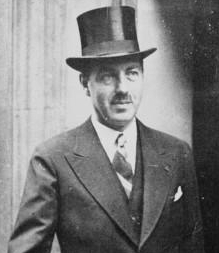Paul van Zeeland facts for kids
Quick facts for kids
Paul van Zeeland
|
|
|---|---|
 |
|
| Prime Minister of Belgium | |
| In office 25 March 1935 – 23 November 1937 |
|
| Monarch | Leopold III |
| Preceded by | Georges Theunis |
| Succeeded by | Paul-Emile Janson |
| Personal details | |
| Born |
Paul Guillaume van Zeeland
11 November 1893 Soignies, Belgium |
| Died | 22 September 1973 (aged 79) City of Brussels, Belgium |
| Political party | Catholic Party |
Paul Guillaume, Viscount van Zeeland (11 November 1893 – 22 September 1973) was a Belgian lawyer, economist, Catholic politician, and statesman born in Soignies.
Van Zeeland was a professor of law and later director of the Institute of Economic Science at the Catholic University of Leuven (Leuven), and vice-governor of the National Bank of Belgium.
In March 1935, he became the prime minister of a government of national unity (a coalition comprising the three major parties: Catholics, Liberals and Socialists). Given decree powers, he abated a national economic crisis by devaluing the currency and implementing expansive budgetary policies.
Van Zeeland's government resigned in the spring of 1936 due to the agitation of Rexism (a Belgian fascist party). On 24 May 1936, a general election took place. The Labour party won 70 of 202 seats (minus 3), Zeeland's Catholic Party 61 seats (minus 18) and the new Rexists 21 seats. Van Zeeland continued as Prime Minister leading a government of national unity, composed of the three major parties (Catholics, Socialists and Liberals). On 2 June 1936, a wildcat strike among dockworkers in the Port of Antwerp broke out and quickly spread to other industrial regions without the endorsement of the country's major trades unions. It was characterised by the new tactic of workplace occupations. The Belgian strike was unusual in uniting socialist and Catholic trade union federations in support. Van Zeeland agreed to convene a National Labour Conference (Conférence Nationale du Travail) on 17 June 1936 to bring together trade union and company representatives. It brokered a compromise agreement including the introduction of a legal minimum wage, six days' paid holidays, and a maximum 40-hour working week for workers in particular industrial occupations. The strike formally ended on 2 July 1936. Van Zeeland was PM until 23 November 1937. After proclaiming martial law, his second government suppressed the Rexists. It introduced measures against unemployment, which helped ease the political tensions. Also during his second term, Belgium gave up its military alliance with France and reverted to its traditional "neutrality" policy, now dubbed a "policy of independence".
In spring 1937, the rexist Léon Degrelle blamed him for having received money from the Belgian Nation Bank. Zeeland denied that but a commission found out he had received 330.000 bfr. Zeeland resigned and the king named Paul-Emile Janson as new PM.
In 1939, Van Zeeland became president of the Committee on Refugees, established in London, and was made High Commissioner for repatriating displaced Belgians in 1944. He was elected to the American Philosophical Society in 1942. In 1946, he was one of the founders of the European League for Economic Cooperation.
After the war, he served as Minister of Foreign Affairs in several Catholic governments between 1949 and 1954 and as economic advisor to the Belgian government and to the council of ministers of the North Atlantic Treaty Organisation. He was Honorary Secretary General of the Steering Committee of the Bilderberg meeting.
In 2013, to the consternation of his family, it was discovered that he had founded a Panamanian offshore company.
See also
 In Spanish: Paul van Zeeland para niños
In Spanish: Paul van Zeeland para niños
- Belgian general strike of 1936

